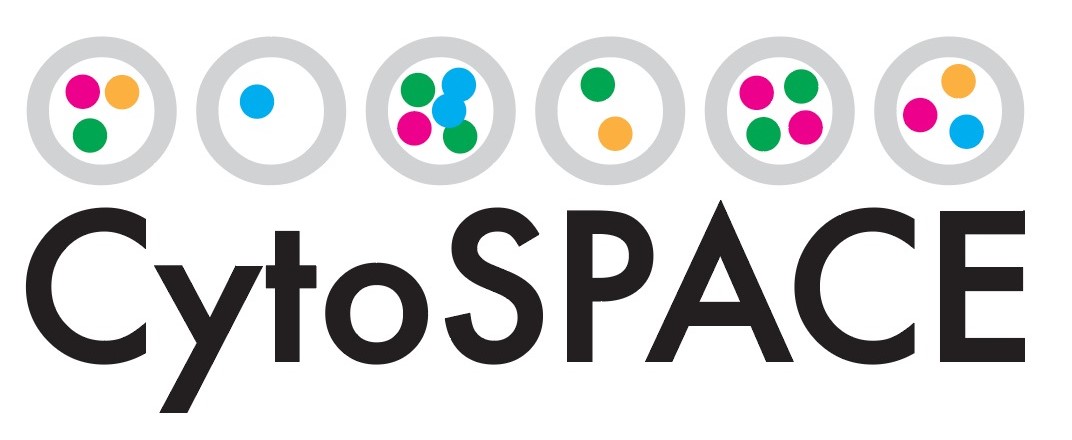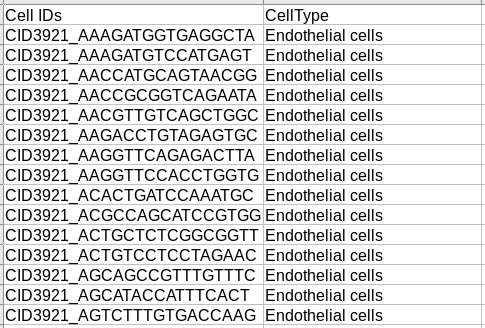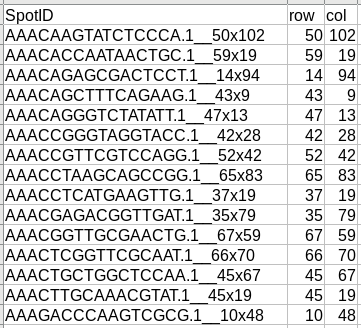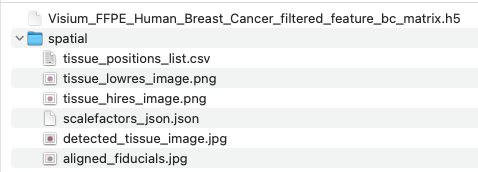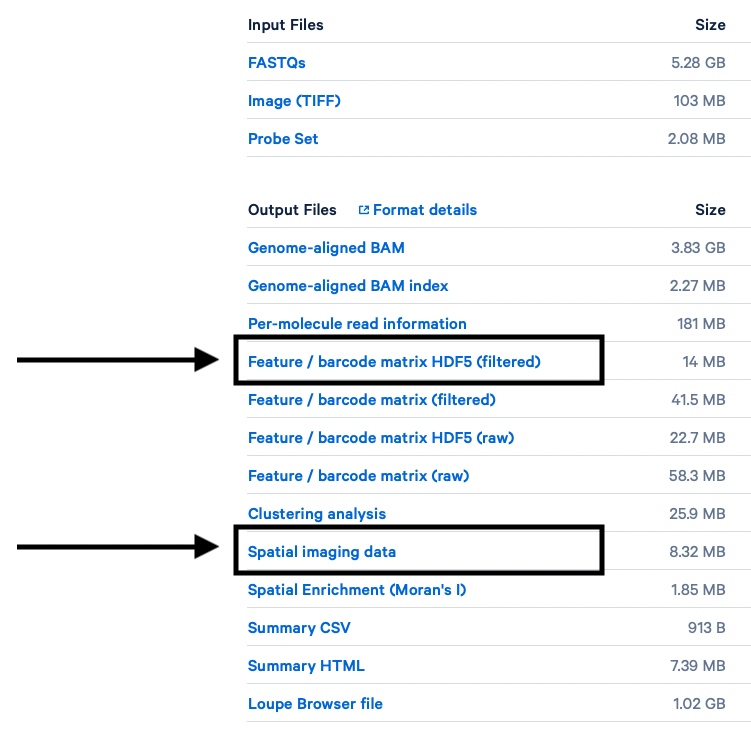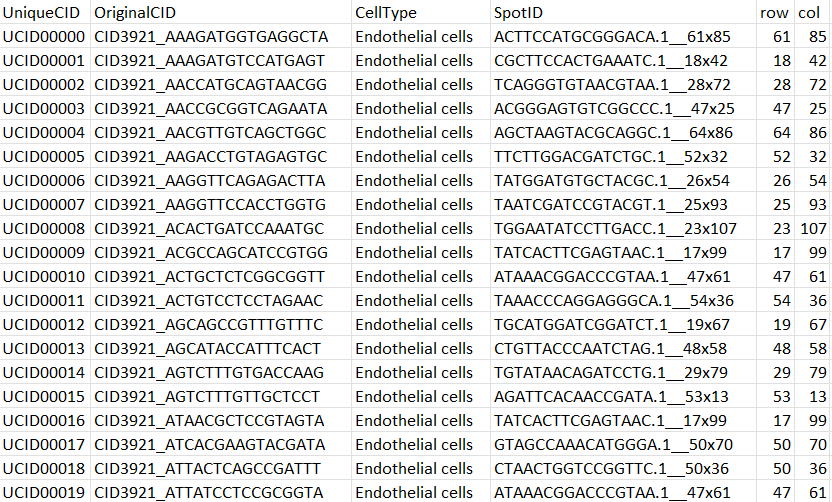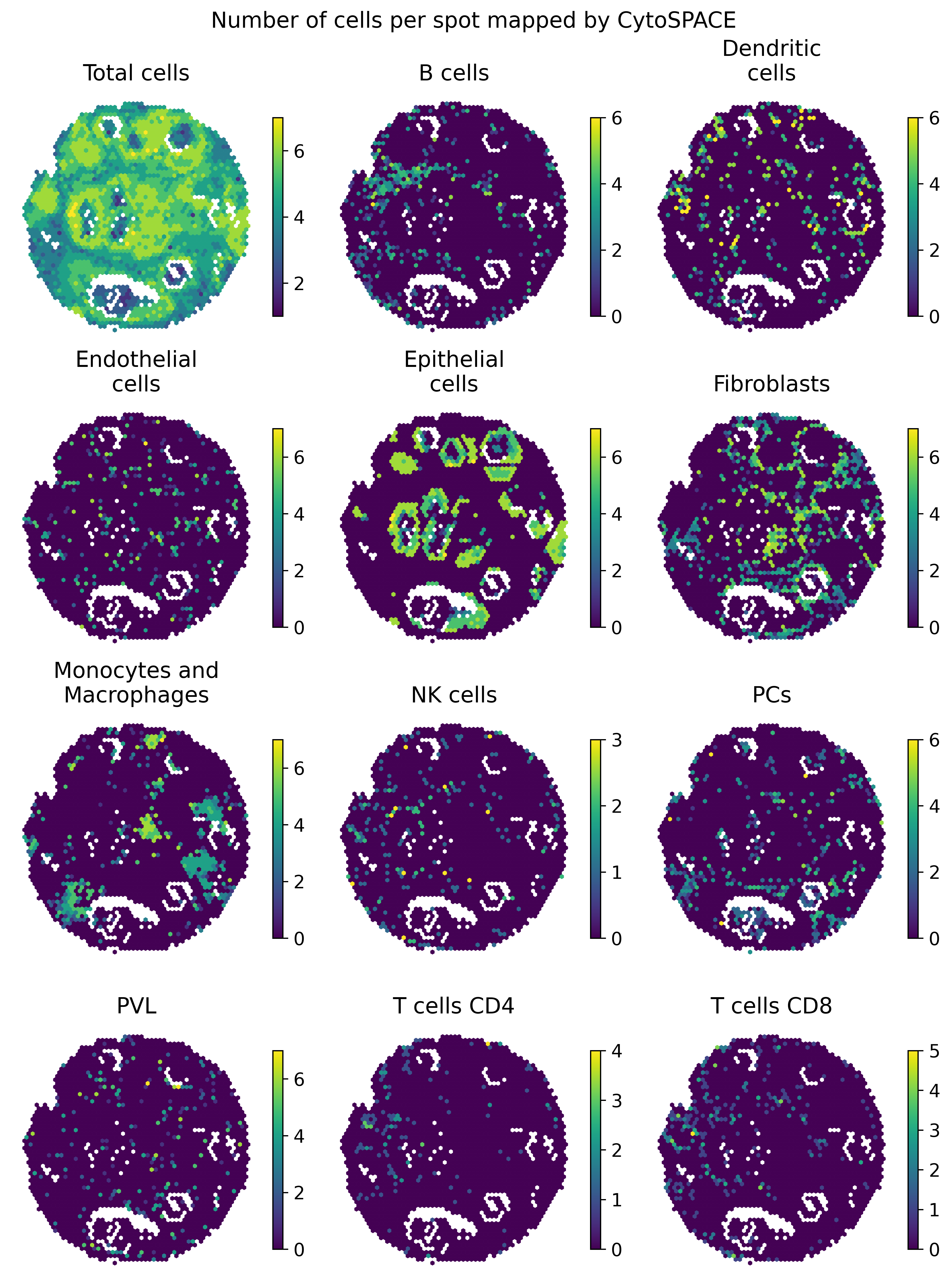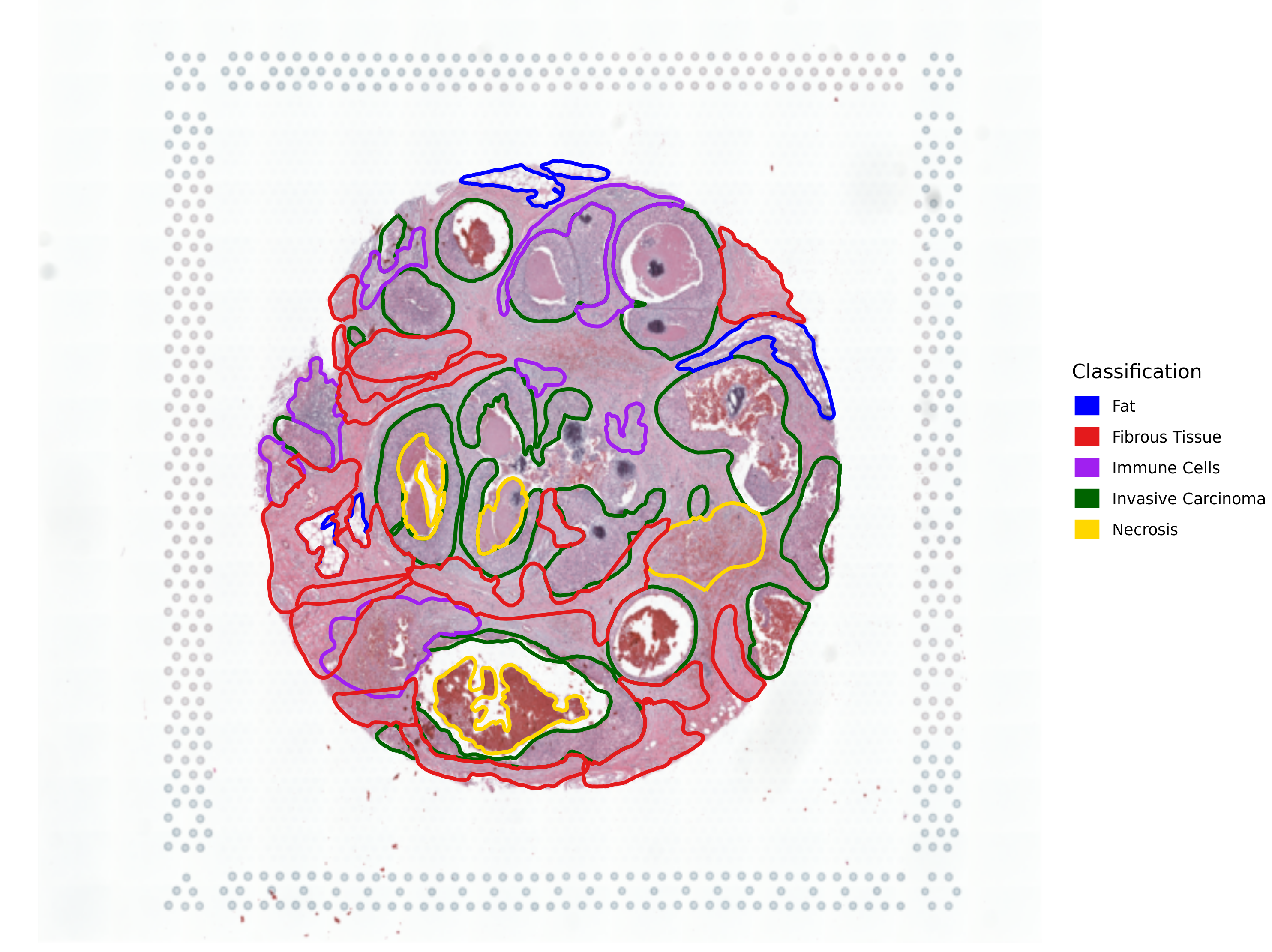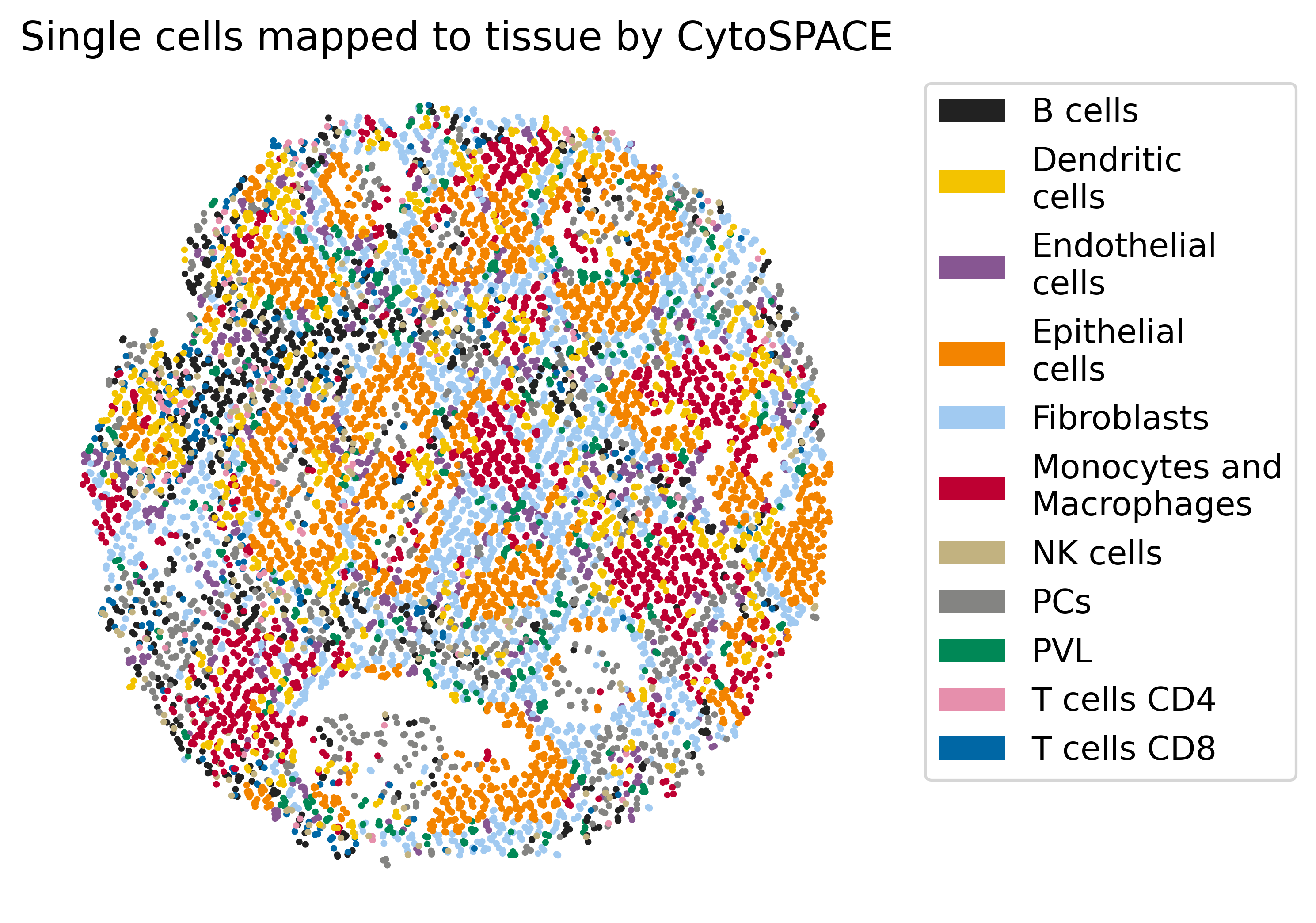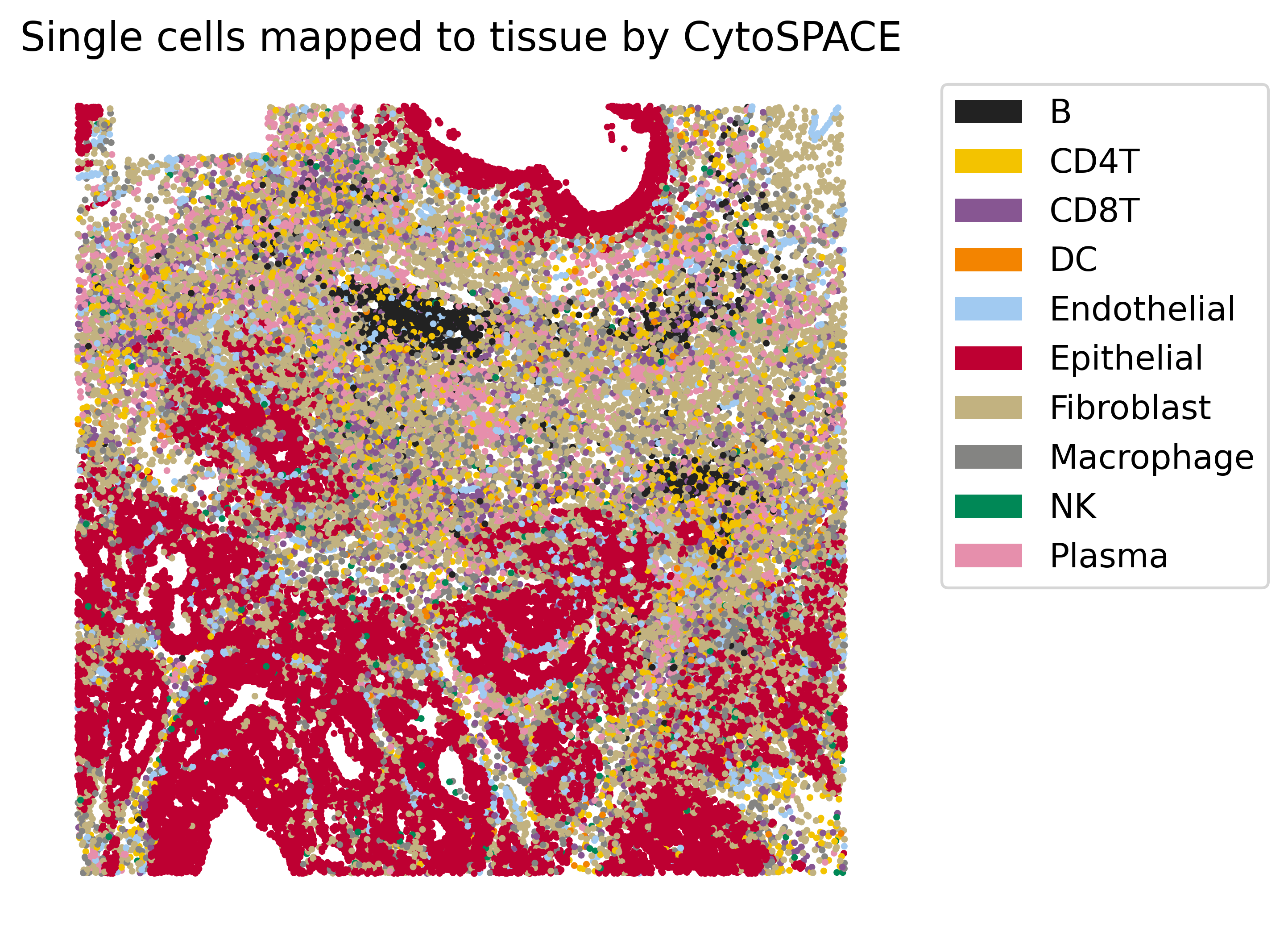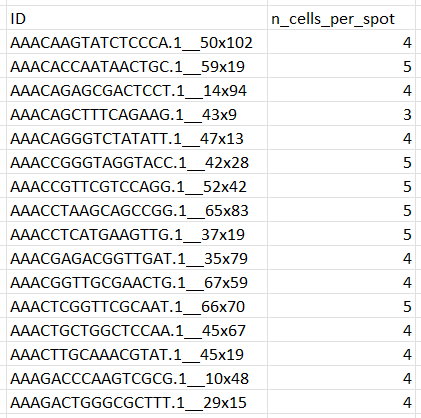CytoSPACE is a novel computational tool for assigning single-cell transcriptomes to in situ spatial transcriptomics (ST) data. Our method solves single cell/spot assignment by minimizing a correlation-based cost function through a shortest augmenting path optimization routine.
The key innovations of our method are:
- Unlike conventional methods which calculate cell type decompositions by spot, CytoSPACE yields a reconstructed tissue specimen with both high gene coverage and spatially-resolved scRNA-seq data suitable for downstream analysis.
- CytoSPACE is highly robust to noise and returns globally optimal cell-to-spot assignments. (See the paper for full details.)
- Unlike other methods which generally operate on pre-selected marker genes or on a shared embedding space (the latter of which can erase true biological variation), CytoSPACE uses the full transcriptome without the need for batch correction, helping it retain sensitivity to subtle cell states.
- CytoSPACE is quick and simple to execute. It runs in minutes even with a single CPU on a personal laptop and requires no hyperparameter tuning or gene/feature selection.
CytoSPACE is available through a web interface at cytospace.stanford.edu, which enables users to run CytoSPACE with default settings without downloading the source code.
Expand section
-
Install Miniconda if not already available.
-
Clone this repository:
git clone https://github.com/digitalcytometry/cytospace- Navigate to
cytospacedirectory:
cd cytospace- (5-10 minutes) Create a conda environment with the required dependencies:
conda env create -f environment.yml- Activate the environment you just created:
conda activate cytospace_v1.1.0cytospace_v1.1.0 is the environment name in the latest version of the file. If you have a different version, which you can check on the first line of the environment.yml file, replace cytospace_v1.1.0 with your version name in the conda activate command.
- (~30 seconds) Install CytoSPACE by executing:
pip install .- (Recommended, ~1 minute) Install package
lapjvby executing:
pip install lapjv==1.3.14We highly recommend you install this package, which provides a fast implementation of the default core optimization algorithm within CytoSPACE.
Step 7 may result in an error depending on your system, as the package requires CPU support for AVX2 instructions that not all systems support. To determine if your system supports this package, it is generally easiest to simply attempt to install it as above. If it installs without problems, your system will support it! If you run into an error, it is likely that your system does not support it, and you can simply use one of the other options we have provided by specifying the --solver-method (-sm) parameter in your call to CytoSPACE. See Running CytoSPACE - Choosing a solver for details.
Please note that, if the package successfully installs but you receive an "illegal instruction" error while running CytoSPACE, you may be able to build the package instead with the following command:
pip3 install git+https://github.com/src-d/lapjvFor more information, see the lapjv documentation page.
Expand section
By default, CytoSPACE requires 4 files as input. All files should be provided in a tab-delimited tabular input format (.txt) with no double quotations. Further formatting details for each input file are specified below. At the end of this section, we also provide instructions on using scripts to generate input files from Seurat objects.
- A scRNA-seq gene expression file:
- The matrix must be genes (rows) by cells (columns).
- The first row must contain the single cell IDs and the first column must contain the gene names.
- The first column (gene names) must have a header.
- The gene expression data should be represented as non-normalized counts.
- All instances of duplicate gene names will be dropped at runtime.
- A cell type label file:
- Cell type labels corresponding to the single cell IDs in the scRNA-seq gene expression matrix.
- Cell type label strings should not have special characters.
- The table should contain two columns, where column 1 contains the single cell IDs corresponding to the columns of the scRNA-seq matrix and column 2 contains the corresponding cell type labels.
- The columns must have a header.
- A spatial transcriptomics (ST) gene expression file:
- The matrix must be genes (rows) by ST spots (columns).
- The first row must contain the ST spot IDs and the first column must contain the gene names.
- The first column (gene names) must have a header.
- The gene expression data should be represented as non-normalized counts.
- All instances of duplicate gene names will be dropped at runtime.
- A spatial transcriptomics coordinates file:
- A table consisting of 3 columns, where the first column contains the ST spot IDs corresponding to the columns of the ST gene expression matrix and columns 2 and 3 contain the row and column indices of each ST spot, respectively.
- The columns must have a header.
If the users are starting from Space Ranger outputs, they can provide the ST input files as a single tar.gz, in place of both (3) gene expression and (4) coordinates. If a Space Ranger output is specified, CytoSPACE will automatically attempt to unzip the provided tarball and load the correponding ST expression and coordinates data.
If there are duplicate gene names in the gene expression file, they will be made unique as is done in Seurat.
The tarball should only include the following:
- A single H5 file (extension .h5) containing the ST gene expression
- A single subdirectory containing the image data
With the above items inside a directory named spaceranger_input, a tarball can be generated using the following command:
tar -cvzf sr_input.tar.gz spaceranger_inputOr more generally:
tar -cvzf [name_of_tarball] [name_of_directory]An example file tree for an unzipped tarball is shown below on the left. If downloading from the public 10X Visium data, users can download the files shown below on the right.
Starting with CytoSPACE v1.1.0, the tool supports Space Ranger v2.0.0+ outputs. This is done by detecting files that have updated naming conventions (namely, the tissue_positions.csv file), then saving a copy of those files to the same directory with a naming convention that is compatible with scipy's functionality to read Visium datasets.
Starting with CytoSPACE v1.0.5, users may also provide the scRNA or ST gene expression as sparse matrices instead of tab- or comma-delimited files.
This will require a very specific set of file names in hopes of avoiding issues with parsing, and we recommend that users use the R helper scripts under Prepare_input_files to generate these input. Please see the subsections below for further information about these helper scripts.
If providing input as sparse matrices, you will need three files under the same directory to represent one expression matrix: [expression].mtx, genes.tsv, and cells.tsv. The .mtx file will list the numeric values in sparse matrix format, and can also be in a compressed [expression].mtx.gz format. The filename inside the brackets (expression) may vary. The genes.tsv and cells.tsv will be the corresponding gene names and cell (or spot/barcode) names for the matrix, located in the same directory as the matrix file.
Starting CytoSPACE v1.1.0, the tool also supports alternative naming conventions (features.tsv and barcodes.tsv), that are according to common Space Ranger and Cell Ranger sparse matrix outputs. These files support .csv extension, and compressed .gz formats as well. The files should have one entry on each line (no headers). If there are multiple columns in any of the files, CytoSPACE will take the first column as the gene/cell names. Please note that for common Cell Ranger and Space Ranger sparse matrix inputs, the first column of the gene file usually has the Ensembl IDs, while the gene symbols are in the second column, so you would need to change the order of the columns if your other input modality contains gene symbols for the gene names.
The [expression].mtx file should be supplied as the argument to --st-path or --scRNA-path, in which case CytoSPACE will automatically try to locate the corresponding gene and cell files from the same directory.
Please ensure the gene file includes gene names with the same naming convention (e.g., Ensembl gene ID, HGNC gene symbol, etc.) as those in the provided ST data.
Preparing input files from Seurat objects
If you have data in the form of Seurat objects, you can generate files formatted for CytoSPACE input via helper functions we have provided in the R script generate_cytospace_from_seurat_object.R in cytospace/Prepare_input_files. To use these helper functions, first import them from generate_cytospace_from_seurat_object.R by including
source('/path/to/generate_cytospace_from_seurat_object.R')in your R script.
For producing CytoSPACE inputs from scRNA Seurat objects, we provide the function generate_cytospace_from_scRNA_seurat_object which may be called as
generate_cytospace_from_scRNA_seurat_object(scRNA_Seurat_Object, dir_out='.', fout_prefix='', write_sparse=FALSE, rna_assay='RNA')within your R script.
scRNA_Seurat_Object (required) : input Seurat object
dir_out (optional, default is working directory) : the path to the output directory to store the results
fout_prefix (optional, default is none) : a prefix to add to output file names, which otherwise are generated as scRNA_data.txt and cell_type_labels.txt
write_sparse (optional, default is FALSE) : whether to save the expression data in sparse matrix format
rna_assay (optional, default is RNA) : which assay to take the count matrix from
Please note that Idents(scRNA_Seurat_Object) must be set to include cell types.
For producing CytoSPACE inputs from ST Seurat objects, we provide the function generate_cytospace_from_ST_seurat_object which may be called as
generate_cytospace_from_ST_seurat_object(ST_Seurat_Object, dir_out='.', fout_prefix='', write_sparse=FALSE, slice='slice1')within your R script.
ST_Seurat_Object (required) : input Seurat object
dir_out (optional, default is working directory) : the path to the output directory to store the results
fout_prefix (optional, default is none) : a prefix to add to output file names, which otherwise are generated as ST_data.txt and Coordinates.txt
write_sparse (optional, default is FALSE) : whether to save the expression data in sparse matrix format
slice (optional, default is slice1) provides the name of your slice as stored in your Seurat object.
Expand section
After activating the cytospace conda environment via conda activate cytospace, CytoSPACE can be called from the command line from any folder using cytospace. More examples on how to run CytoSPACE are provided in the Example dataset for running CytoSPACE section below.
A typical CytoSPACE run with default settings would look like this:
cytospace \
--scRNA-path /path/to/scRNA_geneexpression \
--cell-type-path /path/to/scRNA_celllabels \
--st-path /path/to/ST_geneexpression \
--coordinates-path /path/to/ST_coordinatesOr with more condensed parameter names:
cytospace \
-sp /path/to/scRNA_geneexpression \
-ctp /path/to/scRNA_celllabels \
-stp /path/to/ST_geneexpression \
-cp /path/to/ST_coordinatesAlternatively, if starting from a Space Ranger output, the command may look like this:
cytospace \
--scRNA-path /path/to/scRNA_geneexpression \
--cell-type-path /path/to/scRNA_celllabels \
--spaceranger-path /path/to/spaceranger_output.tar.gz cytospace -sp /path/to/scRNA_geneexpression \
-ctp /path/to/scRNA_celllabels \
-srp /path/to/spaceranger_output.tar.gzFor full usage details with additional options, see the Extended usage details section below.
CytoSPACE provides three solver options. In short, we recommend using the default option lapjv if your system supports AVX2 (i.e., if you were able to successfully install it with pip install lapjv==1.3.14 on Step 7 of the installation) and lap_CSPR otherwise. No options are required to use the default solver lapjv. To use lap_CSPR instead, pass the argument -sm lap_CSPR to your cytospace call. For full solver details, see the CytoSPACE solver options section below.
Other ways CytoSPACE can be run
- You can import methods or functions from
CytoSPACEin python and modify/create your own pipeline. For example:
from cytospace import cytospace
for mean_cell_numbers in [5, 10, 20]:
cytospace.main_cytospace(..., mean_cell_numbers=mean_cell_numbers)Expand section
CytoSPACE will produce six output files by default.
cell_type_assignments_by_spot.pdf
Heatmaps of cell type assignments within the ST sample. Along with a plot showing the total number of cells mapped to each spot, these show the spatial distribution of cell type assignments. Color bars indicate the number of cells of the respective cell type inferred per spot.cell_type_assignments_by_spot_jitter.pdf
A single scatterplot showing all assigned cells by their spot location. Each cell is colored based on its cell type.assigned_locations.csv
This file will provide the assigned locations of each single cell mapped to ST spots. As some cells may be mapped to multiple locations depending on the size of the input scRNA-seq set, new cell IDs (UniqueCID) are assigned to each cell and given in the first column. The second column includes original cell IDs (OriginalCID); the third column includes corresponding cell types (CellType); the fourth column includes assigned spot IDs (SpotID); and the fifth and sixth columns respectively includerowandcolumnindices, or xy-coordinates such asXandYif provided in the initial coordinates file, of the corresponding spots.assigned_expression, a directory withbarcodes.tsv,genes.tsv, andmatrix.mtx(CytoSPACE v1.0.6+)
This represents the gene expression of the resulting assignments, with rows as genes and columns as cells (UniqueCIDofassigned_locations.csv), as recovered from the original input scRNA matrix. The expression data can be read in for downstream analyses using functions such as SeuratRead10X()or SciPyio.mmread(). As withassigned_locations.csv, please note that there may be cells that are assigned to multiple locations and therefore appear multiple times in the expression matrix (under differentUniqueCIDs).
For compatibility with the default parameters of SeuratRead10X(),genes.tsvlists the gene names in its second column, with the first column filled withNAs.cell_type_assignments_by_spot.csv
This file gives the raw number of cells of each cell type per spot bySpotIDas well as the total number of cells assigned to that spot.fractional_abundances_by_spot.csv
This file gives the fractional abundance of cell types assigned to each spot bySpotID.unassigned_locations.csv
This file contains the list of spots (locations) where no cells have been assigned by the algorithm. The columns include the spot IDs (rownames), the row (row) and column (col) indices of the spots, and the total number of cells in each spot (Number of cells), which is 0 for all the spots in this file.log.txt
This file contains a log of CytoSPACE run parameters and running time.
Expand section
-
My ST dataset comes from a platform other than 10x Visium. Which additional parameters should I specify?
Please refer to further instructions in the corresponding sections below:
Running CytoSPACE on legacy ST data and Running CytoSPACE on single-cell ST data. -
My scRNA-seq dataset comes in a format other than a UMI count matrix.
You may want to make the following two changes to the default CytoSPACE workflow.
(1) CytoSPACE's internal algorithm for estimating cell type fractions was generally written with a UMI count matrix in mind. As an alternative to using the internal algorithm, you may provide a--cell-type-fraction-estimation-pathfile instead. Please see Advanced Options - User-provided fractional composition of each cell type for more information.
(2) CytoSPACE (v1.0.4+) downsamples scRNA-seq datasets to a certain number of transcripts per cell (1500 by default) prior to assignment so that the assignment is not dependent on the total transcript count of each cell. You can turn this feature off by appending a--downsample-offflag to the CytoSPACE call, and may instead choose to provide previously downsampled scRNA-seq data as input. -
During runtime, I get a
Killed/Terminated/Segmentation fault/concurrent.futures.process.BrokenProcessPoolerror.
While these errors could arise from a variety of reasons, it is likely that the CytoSPACE run needs more memory than what is available.
We provide a subsampling routine where the ST datasets are partitioned into smaller subsets and evaluated one subset at a time, which reduces memory requirements. Please see Advanced Options - Spot subsampling for parallelization for more information.
If you are experiencing this error with a single-cell ST dataset, it will be helpful to reduce the-nossparameter instead. -
My input data are very sparse. Is there a way to provide sparse matrices as input?
As of CytoSPACE v1.1.0, CytoSPACE supports sparse matrices as input, for both single cell and spatial datasets. This applies both to the main cytospace function and to the get_cellfracs_seuratv3 R script for estimation of the fractional composition of each cell type. While the input still needs to follow a fixed logic of file naming, we broadened compatibility to include the most common naming conventions and extensions for different versions of Cell Ranger and Space Ranger sparse matrix outputs. Please refer to the Input Files - Using sparse matrices for gene expression section for details.
- Providing the output from Space Ranger (v2.0.0+) results in an error.
As of CytoSPACE v1.1.0, CytoSPACE supports the output from Space Ranger (v2.0.0+). Please refer to the Input Files - From Space Ranger outputs section for details.
Expand section
For users to test CytoSPACE, we have included files for an example run:
- A HER2+ breast cancer scRNA-seq atlas by Wu et al. (Nature Genetics, 2021) and a HER2+ breast cancer FFPE specimen profiled by the Visium platform (10x Genomics). Default parameters were selected with Visium samples in mind and are appropriate here.
A zip file containing the example dataset can be downloaded from the following link:
Once the example files are downloaded and unzipped, the commands below can be run from inside the unzipped directory:
cytospace -sp brca_scRNA_GEP.txt -ctp brca_scRNA_celllabels.txt -stp brca_STdata_GEP.txt -cp brca_STdata_coordinates.txt -o cytospace_results_brca -sm lap_CSPRPlease note that here we use the lap_CSPR solver for compatibility. If your system supports AVX2 intrinsics, you can run the same commands without the final argument to use the lapjv solver instead. The CytoSPACE run should take around 5 minutes.
The main output from a CytoSPACE run is the file named assigned_locations.csv, which provides the ST spots to which the single cells have been assigned.
The CytoSPACE results are visualized in heatmaps saved as cell_type_assignments_by_spot.pdf showing the distribution of single cells across ST spots for each cell type. Color bars indicate the number of cells of the respective cell type inferred per spot. Below are the heatmaps produced for the example BRCA data.
For comparison, consider the pathologist annotations of this ST sample as provided by 10x:
CytoSPACE also provides a scatterplot showing cells of all types at once near their spot location, saved as cell_type_assignments_by_spot_jitter.pdf. Each cell is colored by its cell type. Below is the plot produced for the example BRCA data.
The number of cells per spot by cell type as well as in total are provided in the file cell_type_assignments_by_spot.csv. Fractional abundances of each cell type are returned in the file fractional_abundances_by_spot.csv. A log file recording CytoSPACE inputs and running times is output in the file log.txt.
A zip file of the expected CytoSPACE outputs (with CytoSPACE v1.0.0 using the lap_CSPR solver) are available to download at the following link:
Simulated datasets
In addition to the example dataset above, the simulated datasets that we have generated for evaluating robustness of CytoSPACE across different conditions are available for download below.
They were generated using annotated Slide-seq datasets of mouse cerebellum and hippocampus sections from Rodriques et al. (Science, 2019). Each simulated dataset contains subdirectories for data generated using different spot resolutions (5, 15, and 30 cells per spot), as well as an scRNA subdirectory containing reference single-cell datasets with perturbations in a defined percentage of genes. For more information, please see the Methods section of the paper.
Expand section
By default, the CytoSPACE parameters have been optimized for standard 10x Visium spatial slides. Datasets generated by the legacy ST platform can be run with similar commands, but we recommend that the following parameters be adjusted:
--mean_cell_numbers, or-mcn, should be set to20. The legacy ST platform has larger spot sizes, so we recommend mapping an average of 20 cells per spot.--geometry, or-gshould be set tosquare. This will allow the plot function to shape each spot as a square rather than a hexagon.
Similar to the example breast cancer dataset above, we provide an example dataset below:
- A melanoma scRNA-seq atlas by Tirosh et al. (Science, 2016), and a melanoma specimen profiled by the legacy ST platform (Thrane et al., Cancer Research, 2018).
The zip file containing the dataset can be downloaded here.
Running CytoSPACE with the command below generates the results shown here . The format of the output will be the same as the breast cancer dataset above. Please note that here we specify the -ctfep parameter instead of using CytoSPACE's internal algorithm for estimating cell fractions (see Advanced options - User-provided fractional composition of each cell type) as the scRNA-seq atlas used as reference was generated using Smart-seq2. If using CytoSPACE v1.0.4+, the --downsample-off flag should additionally be specified.
cytospace -sp melanoma_scRNA_GEP.txt -ctp melanoma_scRNA_celllabels.txt -stp melanoma_STdata_slide1_GEP.txt -cp melanoma_STdata_slide1_coordinates.txt -ctfep melanoma_cell_fraction_estimates.txt -o cytospace_results_melanoma -mcn 20 -g square -sm lap_CSPRExpand section
While designed for Visium-type data in which most spots contain RNA from multiple cells, CytoSPACE can also be used with single-cell resolution spatial data such as Vizgen's MERSCOPE platform. We expect this extension to be useful for reducing noise and expanding transcriptome coverage of each cell in the ST data, which in turn could allow for identifying spatially-dependent changes across genes more diverse than what a typical single-cell resolution ST platform alone can provide.
For the single-cell resolution mode, CytoSPACE partitions the ST data into smaller subsets and utilizes multiple CPU cores to assign downsampled versions of the reference scRNA-seq data to these regions.
To run CytoSPACE in single-cell mode, please add the following parameters to your command:
--single-cell(-sc), which tells CytoSPACE to run in single-cell mode.- Cell types for the ST dataset. Please note that for the single-cell mode, CytoSPACE does not support the internal estimation of cell type fraction, and the users are expected to specify one of the two options below.
(1)--st-cell-type-path(-stctp)
If the cell types for individual spots are available, we recommend using this option. This file will list the cell type labels for each spot, in the same format as the scRNA-seq cell type labels specified under--cell-type-path. All of the cell types present in--st-cell-type-pathmust also be present in--cell-type-path.
(2)--cell-type-fraction-estimation-path(-ctfep)
However, if the user does not have access to the cell types for each individual spot, they can instead use this option. See the Advaced Options - User-provided fractional composition of each cell type section regarding how this file should be formatted. --number-of-processors(-nop), which denotes the number of cores to use.--number-of-selected-spots(-noss), which denotes the number of ST spots in each subset. We generally recommend-noss 10000.
To run CytoSPACE with single-cell resolution spatial data:
cytospace --single-cell \
--scRNA-path /path/to/scRNA_geneexpression \
--cell-type-path /path/to/scRNA_celllabels \
--st-path /path/to/ST_geneexpression \
--coordinates-path /path/to/ST_coordinates \
--st-cell-type-path /path/to/ST_celllabels \
--number-of-processors NUMBER_OF_PROCESSORS \
--number-of-selected-spots NUMBER_OF_SELECTED_SPOTSOr with more condensed parameter names:
cytospace -sc \
-sp /path/to/scRNA_geneexpression \
-ctp /path/to/scRNA_celllabels \
-stp /path/to/ST_geneexpression \
-cp /path/to/ST_coordinates \
-stctp /path/to/ST_celllabels \
-nop NUMBER_OF_PROCESSORS \
-noss NUMBER_OF_SELECTED_SPOTSA zip file of example single cell inputs is available to download from Google Drive here.
To run CytoSPACE with this example dataset, run the following command from the location of the unzipped inputs and with your CytoSPACE conda environment active:
cytospace \
-sp HumanColonCancerPatient2_scRNA_expressions_cytospace.tsv \
-ctp HumanColonCancerPatient2_scRNA_annotations_cytospace.tsv \
-stp HumanColonCancerPatient2_ST_expressions_cytospace.tsv \
-cp HumanColonCancerPatient2_ST_coordinates_cytospace.tsv \
-stctp HumanColonCancerPatient2_ST_celltypes_cytospace.tsv \
-o cytospace_results_crc \
-sm lap_CSPR \
-sc -noss 10000 -nop 2Running CytoSPACE in the --single-cell mode will output the assignments assigned_locations.csv, the plot cell_type_assignments_by_spot_single_cell.pdf, and the log file log.txt. The plot generated will be a scatterplot of the cells colored by cell type, as shown below for the example dataset. The full results for the example dataset using the above command is available for download here.
While the default options are recommended for most use cases, we do provide additional advanced options.
User-provided fractional composition of each cell type (-ctfep)
To account for the disparity between scRNA-seq and ST data in the number of cells per cell type, CytoSPACE requires the fractional composition of each cell type in the ST tissue. By default, CytoSPACE will generate this information by internally calling the get_cellfracs_seuratv3.R script using the input files. This script uses Seurat v3, which is installed as part of the CytoSPACE environment. We highly recommend using Seurat v3 over Seurat v4 for the purposes of cell type fraction estimation.
While our provided script uses Spatial Seurat, there is a diverse set of other approaches available such as cell2location, SPOTlight, or CIBERSORTx.
Users may choose to skip CytoSPACE's internal algorithm and instead provide their own file for the estimated cell type composition of the ST dataset, specified with the --cell-type-fraction-estimation-path (-ctfep) flag. In particular, we recommend that a separate -ctfep file be provided if the reference scRNA-seq dataset comes from technologies that are not based on UMI counts, such as Smart-seq.
The provided file must be a table consisting of 2 rows with row names, where the first row contains the cell types and the second row contains the cell fractions of each cell type represented as proportions between 0 and 1. Please make sure that the cell type labels in the first row match the labels present in the cell type label file, and that the cell type fractions sum to one. Row names must be present for both rows.
User-provided estimates of number of cells per spot (-ncpsp)
Rather than using the internal mechanism of CytoSPACE for estimating the number of cells per spot, users can provide their own estimates (from image segmentation, for example) in a two-column file with header, in which the first column contains spot IDs and the second contains the number of cells predicted per spot:
To run CytoSPACE with this option, pass the flag -ncpsp or --n-cells-per-spot-path followed by the file location.
Spot subsampling for parallelization (-sss)
The memory and runtime required for running CytoSPACE may vary based on the number of spots. To allow for CytoSPACE to run under different conditions, we provide an option to partition the estimated number of cells in the ST sample into smaller chunks, where similarly downsampled reference scRNA-seq data are then assigned using multiple CPU cores. Please note that this option is only for non-single-cell ST datasets (10x Visium and legacy ST); users running CytoSPACE on single-cell ST data should instead modify the -noss parameter to achieve the same effect.
The users can use this option by specifying the --sampling-sub-spots (-sss) flag, along with the desired number of subsampled cells per partition (--number-of-selected-sub-spots, or -nosss) and the number of cores to be used (--number-of-processors, or -nop). Please note that the right -nosss/-nop combination will be highly dependent on the user's system configurations, and one may need to try different combinations to see which one allows for a successful run. Ideally, using the highest possible -nosss without going out of memory would be the most effective. We noticed that -sss -nosss 3000 -nop 2 works well for the example BRCA dataset on an environment with 8GB RAM.
The following example command will run CytoSPACE on the example breast cancer dataset, assigning scRNA-seq data to 5000 cells at a time using 2 cores:
cytospace \
-sp brca_scRNA_GEP.txt \
-ctp brca_scRNA_celllabels.txt \
-stp brca_STdata_GEP.txt \
-cp brca_STdata_coordinates.txt \
-o cytospace_results_brca \
-sm lap_CSPR \
-sss -nosss 5000 -nop 2Alternative distance metric (-dm)
By default, CytoSPACE uses Pearson correlation to compare cell and spot transcriptomes. Users can choose to use Spearman correlation or Euclidean distance instead by passing -dm Spearman_correlation or -dm Euclidean respectively with the function call.
Setting a new random seed (-se)
While the CytoSPACE algorithm is mostly deterministic, the initial step of sampling cells to be mapped is done at random. To provide an alternative random seed resulting in a different random sampling of cells, users can pass -se followed by the desired (integer) seed with the function call. The default random seed for CytoSPACE is 1.
Alternative handling of sampling (-sam)
CytoSPACE starts by creating a pool of cells that matches what is expected within the ST data. By default, this is done by resampling single cells to achieve the overall cell type fractions and total cell numbers estimated in the tissue. We recommend that CytoSPACE be run with this default setting for all real data analyses. However, we provide an additional option to generate new "place-holder" cells by sampling from the distribution of gene counts within each cell type instead, and used this option for ensuring uniqueness of mapped cells for benchmarking on simulated data. To run CytoSPACE with this alternative mode, users can pass -sam place_holders with the function call. When running in place-holder mode, the assigned_expression directory will not be generated; instead, the gene expression of the newly generated "place-holder" cells will be saved as part of the output under new_scRNA.csv.
Method extension: mapping quality
While CytoSPACE's formulation as a linear assignment problem guarantees an optimal solution given its cost function, there is no underlying probabilistic framework for estimating mapping uncertainty. One possibility is to determine whether a given cell type belongs to a given spot after mapping - that is, whether a spot contains at least one cell of the same cell type. Notably, this does not distinguish between cells of the same cell type for quality of fit. As such a protocol provides some measure of mapping quality, albeit incomplete, we provide a helper script that implements this via a support vector machine that produces and trains on pseudo-bulks generated from the input scRNA-seq data. This script, uncertainty_quantification.R, takes as input the path to the ST dataset count matrix file, the scRNA-seq count matrix file, and the CytoSPACE output file assigned_locations.csv, and returns an appended output file with confidence scores in assigned_locationswConfidenceScores.csv. The command to run this script following a completed CytoSPACE run is as follows:
Rscript uncertainty_quantification.R /path/to/ST_geneexpression /path/to/scRNA_geneexpression /path/to/assigned_locations.csvFor interpreting confidence scores, we recommend a cutoff of 0.1, with higher scores indicating increased confidence that a spot contains at least one cell of the same cell type.
Please note that uncertainty_quantification.R requires separate dependencies from those included in the provided environment.yml file for the cytospace conda environment. This script should be run in a separate environment with the following R packages installed: Seurat (must be v4; tested with v4.0.1), data.table (tested with v1.14.0), and e1071 (tested with v1.7.8).
Expand section
usage: cytospace [-h] -sp SCRNA_PATH -ctp CELL_TYPE_PATH [-stp ST_PATH] [-cp COORDINATES_PATH] [-srp SPACERANGER_PATH]
[-stctp ST_CELL_TYPE_PATH] [-ctfep CELL_TYPE_FRACTION_ESTIMATION_PATH] [-ncpsp N_CELLS_PER_SPOT_PATH]
[-o OUTPUT_FOLDER] [-op OUTPUT_PREFIX] [-mcn MEAN_CELL_NUMBERS] [--downsample-off]
[-smtpc SCRNA_MAX_TRANSCRIPTS_PER_CELL] [-sc] [-noss NUMBER_OF_SELECTED_SPOTS] [-sss]
[-nosss NUMBER_OF_SELECTED_SUB_SPOTS] [-nop NUMBER_OF_PROCESSORS] [-sm {lapjv,lapjv_compat,lap_CSPR}]
[-dm {Pearson_correlation,Spearman_correlation,Euclidean}] [-sam {duplicates,place_holders}]
[-se SEED] [-p] [-g GEOMETRY] [-nc NUM_COLUMN] [-mp MAX_NUM_CELLS_PLOT]
CytoSPACE is a computational strategy for assigning single-cell transcriptomes to in situ spatial transcriptomics (ST)
data. Our method solves single cell/spot assignment by minimizing a correlation-based cost function through a linear
programming-based optimization routine.
optional arguments:
-h, --help show this help message and exit
-stp ST_PATH, --st-path ST_PATH
Path to spatial transcriptomics data (expressions)
-cp COORDINATES_PATH, --coordinates-path COORDINATES_PATH
Path to transcriptomics data (coordinates)
-srp SPACERANGER_PATH, --spaceranger-path SPACERANGER_PATH
Path to SpaceRanger tar.gz data file
-stctp ST_CELL_TYPE_PATH, --st-cell-type-path ST_CELL_TYPE_PATH
Path to ST cell type file (recommended for single-cell ST)
-ctfep CELL_TYPE_FRACTION_ESTIMATION_PATH, --cell-type-fraction-estimation-path CELL_TYPE_FRACTION_ESTIMATION_PATH
Path to ST cell type fraction file (recommended for bulk ST)
-ncpsp N_CELLS_PER_SPOT_PATH, --n-cells-per-spot-path N_CELLS_PER_SPOT_PATH
Path to number of cells per ST spot file
-o OUTPUT_FOLDER, --output-folder OUTPUT_FOLDER
Relative path to the output folder
-op OUTPUT_PREFIX, --output-prefix OUTPUT_PREFIX
Prefix of results stored in the 'output_folder'
-mcn MEAN_CELL_NUMBERS, --mean-cell-numbers MEAN_CELL_NUMBERS
Mean number of cells per spot, default 5 (appropriate for Visium). If analyzing legacy spatial
transcriptomics data, set to 20
--downsample-off Turn off downsampling for scRNA-seq data
-smtpc SCRNA_MAX_TRANSCRIPTS_PER_CELL, --scRNA_max_transcripts_per_cell SCRNA_MAX_TRANSCRIPTS_PER_CELL
Number of transcripts per cell to downsample scRNA-seq dataset to. This allows for assignments
that are not dependent on the overall expression level
-sc, --single-cell Use single-cell spatial approach if specified
-noss NUMBER_OF_SELECTED_SPOTS, --number-of-selected-spots NUMBER_OF_SELECTED_SPOTS
Number of selected spots from ST data used in each iteration
-sss, --sampling-sub-spots
Sample subspots to limit the number of mapped cells if specified
-nosss NUMBER_OF_SELECTED_SUB_SPOTS, --number-of-selected-sub-spots NUMBER_OF_SELECTED_SUB_SPOTS
Number of selected subspots from ST data to limit the number of mapped cells
-nop NUMBER_OF_PROCESSORS, --number-of-processors NUMBER_OF_PROCESSORS
Number of processors used for the analysis
-sm {lapjv,lapjv_compat,lap_CSPR}, --solver-method {lapjv,lapjv_compat,lap_CSPR}
Which solver to use for the linear assignment problem, default 'lapjv'
-dm {Pearson_correlation,Spearman_correlation,Euclidean}, --distance-metric {Pearson_correlation,Spearman_correlation,Euclidean}
Which distance metric to use for the cost matrix, default 'Pearson_correlation'
-sam {duplicates,place_holders}, --sampling-method {duplicates,place_holders}
Which underlying method to use for dealing with duplicated cells, default 'duplicates'
-se SEED, --seed SEED
Set seed for random generators, default 1
-p, --plot-off Turn create plots on/off
-g GEOMETRY, --geometry GEOMETRY
ST geometry, either 'honeycomb' or 'square' accepted
-nc NUM_COLUMN, --num-column NUM_COLUMN
Number of columns in figure
-mp MAX_NUM_CELLS_PLOT, --max-num-cells-plot MAX_NUM_CELLS_PLOT
Maximum number of cells to plot in single-cell visualization
Required arguments:
-sp SCRNA_PATH, --scRNA-path SCRNA_PATH
Path to scRNA-Seq data
-ctp CELL_TYPE_PATH, --cell-type-path CELL_TYPE_PATH
Path to cell type labels
You can see this list of variables and default values for running CytoSPACE from the commmand line as well at any time by calling cytospace along with the -h or
--help flag, i.e., cytospace -h.
Expand section
lapjv(Recommended for most systems) By default, CytoSPACE calls thelapjvsolver from packagelapjv. This solver is a fast implementation of the Jonker-Volgenant shortest augmenting path assignment algorithm and returns a globally optimal solution given the objective function as defined in our paper. As noted above, however, this package is not supported on all systems as it achieves its speedup through use of AVX2 instructions. This solver will be selected by default and can be specified explicitly by passing arguments--solver-method lapjvor-sm lapjvtocytospace.lap_CSPR(Recommended for systems not supportinglapjv) A second solver option is thelinear_assignmentmethod from theortoolspackage. This solver uses a different method than the first and third options, an assignment algorithm called the cost scaling push relabel method. This algorithm approximates assignment costs to integer values and loses some numerical precision in doing so. Therefore, while it returns a globally optimal solution after approximation given the objective function defined in the paper, it will return similar but generally not identical results to the first two methods. This solver has a similar running time to the first option and is a good option for systems not supporting thelapjvpackage. This solver can be selected by passing arguments--solver-method lap_CSPRor-sm lap_CSPRtocytospace.lapjv_compatA third solver option implements thelapjvsolver from packagelap. Like the first optionlapjv, this solver also implements the Jonker-Volgenant shortest augmenting path assignment algorithm to return the same globally optimal solution given the objective function defined in the paper. Furthermore, it is broadly supported and should work on all standard operating systems. However, it takes 3-4 times as long to run as the first solver option (thelapjvsolver from thelapjvpackage), so we only recommend it for systems that do not support the first option. This solver can be selected by passing arguments--solver-method lapjv_compator-sm lapjv_compattocytospace.
Expand section
To update your local installation of CytoSPACE following updates of this GitHub repository, navigate to your cytospace directory and execute the following commands:
git pull
conda env update --name cytospace --file environment.yml
conda activate cytospace
pip install .If you have made local updates to your version of the CytoSPACE source code, you should execute
pip install .before running.
CytoSPACE was developed in the Newman Lab by
- Milad R. Vahid (miladrv)
- Erin L. Brown (erinlbrown)
- Chloé B. Steen (cbsteen)
- Wubing Zhang (WubingZhang)
- Hyun Soo Jeon (hsjeon-k)
- Aaron M. Newman (aaronmnewman)
If you have any questions, please contact the CytoSPACE team at cytospaceteam@gmail.com.
Please see the LICENSE file.
If you use CytoSPACE, please cite:
High-resolution alignment of single-cell and spatial transcriptomes with CytoSPACE (Nature Biotechnology 2023)
Milad R. Vahid*, Erin L. Brown*, Chloé B. Steen*, Wubing Zhang, Hyun Soo Jeon, Minji Kang, Andrew J. Gentles, Aaron M. Newman.
https://www.nature.com/articles/s41587-023-01697-9
